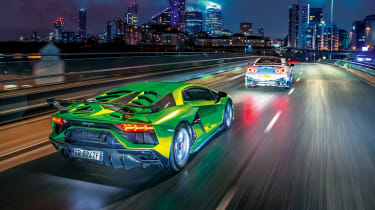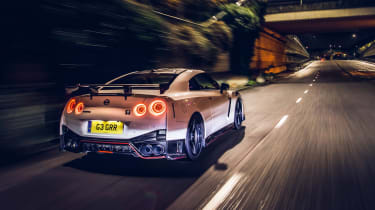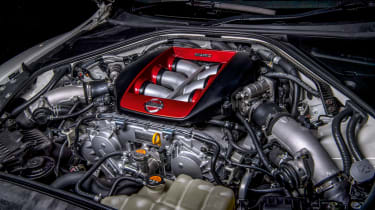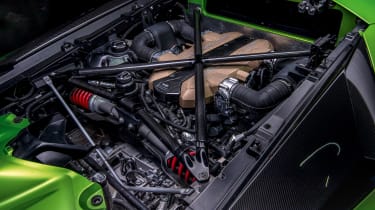Lamborghini Aventador SVJ v Nissan GT-R Nismo
Lamborghini’s Aventador SVJ and Nissan’s GT-R Nismo are two old warriors at their fiercest and most brutal, determined to go out on an adrenaline-fuelled high
It’s almost spooky. The driving environments couldn’t be more different: one elevated on an extreme-looking but nicely squishy seat, your legs bent as they would be in a saloon car, visibility easy and reassuring; the other set behind a vast, raked-back windscreen, seat just a carbon shell with some woefully unsupportive padding and set bolt upright, your legs splayed beneath the fully extended steering column, widescreen door mirrors filled mostly with intakes and huge, sharp-edged wheelarches, and a whole lot of carbonfibre aero addenda visible through the venetian blind-style engine cover when a little more of a rear view might be welcome.
Yet as the road wiggles into the gloom, puddles clawing ominously from the edges of narrow lanes and hiding god- knows-what, these two wildly different machines have the same appetite and enthusiasm; they summon the same unbelievable speed. Extracting it is an exercise in restraint, occasional moments of full-throttle joy and many more in a kind of blind panic as tyres skate over standing water and bumps shuffle the cars off line in a heartbeat. Two cars so extreme they seem to have wholly forgotten about the real world. Especially when it’s gripped by winter.
> Lamborghini Urus Performante 2022 review – a suitably hardcore SUV?
Of course, you could argue that the Lamborghini Aventador never cared too much for the real world. Despite the quantum leap it represented when it replaced the Murciélago way back in 2011, its dynamic qualities always felt as though they looked to the past for inspiration. As Ferraris became ever more useable, embraced electronics to make good their inherent hyper-agility and deliberately prised open their operating window, Lamborghini surged ahead with material technology and pushrod-operated suspension but kept the driving experience resolutely old school. The Aventador was always vast, intimidating, deeply uncomfortable at low speeds and seemingly created for a 30-minute blast of adrenaline rather than a regular dose of more cerebral thrills.
Things change. A little. Magnetic dampers, introduced with the SV in 2015, improved low-speed ride and high-speed control, the purity of the spectacular shape has gradually been supplemented by tricks, flicks, splitters and spoilers and each variant has focused increasingly on track performance. The penultimate iteration, the Aventador SVJ you see here, even set an astonishing lap record around the Nürburgring, only to be beaten by a Manthey-modified 991 GT2 RS and, latterly, by the Mercedes-AMG GT Black Series. The Aventador has been around a full decade but those terrifying 6 minutes and 44.97 seconds demonstrate it’s still relevant in a world of 765LTs and SF90s. At least on a track in the Eifel forest.
Here and now the weather feels distinctly Eifel. Persistent drizzle hangs everywhere, fog comes and goes in great patches and gusts of wind rattle the bare trees and pelt water at the windscreen in great sheets. Later, we’ll thwack and thump around London for photography, but for now the Lambo’s job is to keep four round tail lights in sight on wickedly slimy roads built for cars a size smaller.
Those lights belong to the Nissan GT-R Nismo. Another last hurrah, this time for the oldest performance car on sale today. Unbelievably, production of Nissan’s game-changer started in December 2007. It’s a teenager. Which might explain the fact that it seems so difficult to reason with, refuses to fall in with convention and is so belligerently angry. The SVJ’s 6.5-litre V12 may have 759bhp but hell hath no fury like a hormonal teen. Those tail lights are starting to edge into the distance…
So it’s no ordinary match-up. These cars aren’t ‘rivals’. In fact, neither of these cars has rivals. You don’t choose a GT-R Nismo over, say, a 911 Turbo S. Any more than you weigh up the pros and cons of stretching to an Aventador SVJ instead of a 765LT. You buy them because you can, and because they speak to you. More than any other performance cars on sale today, Nissan’s ultimate GT-R and Lamborghini’s maddest of madmen are statements of devotion. We’ve brought them together not to rationalise their existence, but to remember why they command such affection in the first place.
What’s surprising is that familiarity doesn’t breed even a trace of contempt. Not for me, anyway. How could it when both of these cars specialise in the extraordinary – and do it completely on their own terms? If you don’t smile when you heave the door of the Aventador upwards and then duck beneath it to drop into the cold, hard embrace of the carbonfibre seat, then you’re beyond hope. The GT-R doesn’t require such ceremony but there’s something about the size of this car, the lofty seating position and the blocky, unsophisticated architecture that has a drama all of its own. A Porsche collector poring over shades for the leather-covered air vents on their 14th wildly overthought limited-edition 911 or a Ferrari client perusing Atelier options wouldn’t get it. Which is exactly the point. The GT-R Nismo comes in red, white, black or grey. The interior is black and red. There are no options. You pays your £180,095 and, erm, there aren’t any choices to make.
In return you get a GT-R that’s benefited from well over a decade of evolution and is now laser-focused. The big numbers are 592bhp at 6800rpm and 481lb ft from 3600 to 5800rpm, a top speed of 196mph and a kerb weight of 1703kg. The little ones are 0-62mph in 2.8 seconds and a whole host of incremental weight savings and other measures introduced to cut response time. The new turbochargers are lifted directly from the GT3 racing car and each turbine wheel has ten vanes, one fewer than previously. Those vanes are also 0.3 millimetres thinner. In combination, this reduces inertia by 24 per cent.
Forged wheels are lighter by 25 grams each. Oh yes. The trick Dunlops have one groove fewer in the tread pattern, increasing the contact patch by 11 per cent, and have a slightly rounder shoulder to maintain that advantage even under extreme loads. The roof is now carbonfibre, reducing weight and the centre of gravity. The vents in the wheelarches increase front downforce by 7kg. The carbon-ceramic brakes, with huge, 410mm front discs and 390mm rears, gripped by six- and four-piston calipers respectively, reduce unsprung mass by 16.3kg. The Recaros have a new core structure to increase rigidity by 20 per cent while shedding yet more fat. Each seat is 1.4kg lighter. You can only admire the dedication of the engineers who have made polishing the GT-R formula into a life’s work.
This obsession raises questions and concerns, too. It’s inescapable that, as the GT-R has been painstakingly updated bit-by-infinitesimal-bit, the rest of the world has been tearing up tree trunks. Porsche has launched two entirely new generations of its own sports car in the GT-R’s lifespan and four iterations of 911 Turbo among dozens of variants. Hybrid hypercars have been and gone, a new generation of extreme EVs is just around the corner and the car that once felt as if it had been beamed from the future in terms of sheer ability is now very clearly a throwback to a different time. Look closely enough at the 25-gram-lighter wheels and you might just see Rome collapsing into flames.
Then the Nismo hits you right in the face. The philosophical questions evaporate and you’re suddenly in the thick of the action: eyes wide, knuckles clenched and nervous system on high alert. Thanks to a 30kg weight saving, the switchable Bilstein dampers have been backed off five per cent on compression and
20 per cent in rebound, but you’d barely know it. This is a physical car that finds bumps wherever they might be and shimmies and shuffles on these heavily crowned roads that challenge the suspension with wildly varying conditions across each axle. Throw standing water into the mix and the Nismo feels almost unstable, skipping and slipping and darting as it hunts for grip. The cliché that paints the GT-R as a car that drives itself has always been inaccurate, but in the case of the Nismo on a winter’s day like this it’s nothing short of laughable. Right now, even blinking seems ill-advised.
Unlike that of early GT-Rs, the steering is light and doesn’t have much in the way of texture. Perhaps it’s configured to impart a sense of inertia-free response, but when there’s precious little heat in the tyres you crave more detail and something to lean against. Instead you get a chassis that seems painfully stiff, mixed with steering that’s overly responsive. At least that’s how it feels in those first few minutes. You must adapt to the Nismo. Learn to trust in the front end, which finds fantastic grip even in the wet. Then relax your grip on the wheel and let the car find its own path, nudging it back on line gently rather than chasing the car every time it tramlines or gets deflected by a sharp bump. As you calm your inputs, so the car finds its rhythm. It’s not a fluid, effortless approach but the combative, aggressive style is about as raw and exciting as it gets.
The improvements are real, too, chiefly in terms of engine response with the new turbochargers. The Nismo has superb throttle reactions and the 3.8-litre V6 feels and sounds better than ever. There’s so much torque and it arrives hard and early and builds in a measured but almost overwhelming way. This is precision and savagery blended expertly and the VR38DETT just keeps on going as the limiter approaches, all that muscle carrying you up to the angry part of the power band and the titanium exhaust spitting its approval.
Get greedy with the throttle and the Dunlops spin up quickly; if you’re in a corner when you decide to achieve full boost the GT-R likes to oversteer first and then start to drag itself straight. The process is manic – everything about the Nismo is manic – and can feel pretty scary. They might keep polishing the GT-R format but some rough edges will never be knocked off.
I know all of this as the GT-R’s distinctive lights edge inexorably away from the Aventador SVJ. There’s no doubt in my mind that a standard GT-R would be a faster car than the Nismo in many, many situations. But even compromised by those track-ready spring rates, extreme tyres and weather that gets filthier by the moment, the GT-R is still a mighty thing across a give-and-take road. To give chase seems pointless. The Nismo is out of its comfort zone, certainly, but the SVJ is a Great White in a village pond.
Even with the GT-R still fresh in the memory banks, the Lamborghini feels outrageous. The ride is perhaps a sliver more refined, but such is the noise from the vast tyres and the total lack of sound deadening that it feels even harsher. Those torturous, terrible seats don’t help and everything you touch is cold, bare and hard. To say it’s not a friendly sort of character would be an understatement. I do rather fear that in seeking out lap records the Aventador has lost its warm sense of humour.
In contrast to the Nissan, the steering is heavy and pulsates with the road surface. However, it’s not a pure system and, more so than in the GT-R, you can feel that the Lambo is four-wheel drive at all times. The steering seems to get almost bound-up by the torque transmitted through the front axle and it feels as if the assistance is battling to counter the effect. It’s a curious sensation and creates a sense of heft and reluctance. It’s funny, the square-edged GT-R had felt almost hyperactive and now the Lambo – the car that literally looks like a giant arrow with a great firework up its backside – offers a disparate blend of unyielding, brittle aggression and reluctance to zip into turns. The Nismo almost begs you to feel its agility whereas the Lambo hides it away.
To discover what lays beneath requires the opposite approach to the one demanded by the Nissan. Don’t relax and let the car chart its course. Grab hold and bully it. The Pirellis cut through the standing water incisively so you can place the SVJ with pinpoint accuracy, while despite the adoption of rear-wheel steering this huge car behaves all-of-a-piece. It’s never jumpy, it requires deliberate inputs, but it doesn’t take long for the cold handshake of the SVJ to turn into a big bearhug. Essentially, just as with the Nismo, the SVJ is on your side. You just have to talk its language.
The engine, of course, speaks all of the languages. For the SVJ the 6.5-litre V12 received a new intake system with revised runner lengths, titanium intake valves and a reworked cylinder head, plus a new exhaust system with less back pressure. The result is 759bhp at 8500rpm and 531lb ft at 6750rpm, enough to push the SVJ through the air at over 217mph and cover 0-62mph in 2.8 seconds and 0-124mph in 8.6. Like the Nismo it has been subject to a raft of tweaks and changes – stiffer anti-roll bars by 50 per cent over the SV, damper force increased by 15 per cent, 70 per cent more downforce and active aero with the ALA 2.0 system, and a recalibrated four-wheel-drive set-up that sends three per cent more torque to the rear wheels – while lightweighting brings the kerb weight down to 1525kg. Not bad when you consider that a new 911 Turbo is 1640kg (though that’s a dry weight for the Lambo).
ALA switches off automatically in cold weather and so any chance of feeling ‘aero vectoring’ disappears. Let’s not kid ourselves, there was no chance of this on the road anyway. However, who needs aero efficiency when you have a V12 that revs to 8500rpm and never runs out of breath? The engine, more than anything else, elevates the SVJ beyond merely being a car. Or even a supercar. You don’t drive this thing, you experience it, swim around in its excesses and hope, just once, to find the opportunity to feel the car climb an entire gear and butt momentarily into its limiter before the seven-speed ’box fires home a shift… With light fading and water hanging in the air and pooling on the road surface it takes determination to use 6500rpm without lifting the throttle. The full 8500rpm is a tantalising dream that you keep on chasing.
The ISR ’box remains a frustration. It’s improved and you can smooth things out with a well-timed lift, but to do so seems to melt the crispness of the shifts. Keep the throttle pinned and things go too far the other way, the engineered-in thump feeling crude and slightly stupid. It’s such a shame that you only experience the true potential of the ’box at full throttle and very close to full revs. Here you can keep the throttle wide open and the upshift is phenomenally fast and perfectly judged. There’s still plenty of theatre but it comes from precision and speed rather than being whacked over the head by a virtual sledgehammer of ‘emotion’. Luckily, the scale of the performance on offer and the reach of, say, third or fourth gear is such that you can make stunning progress without relying too much on the gearbox.
Enough to start to zero-in on those four red circles dancing through the gloom? Not easily, but it can be done. The Nismo should get out of the corners so much better but the boost takes careful management in the wet and so the mighty V12 with all its linear power is a big advantage. The Lambo gains a few yards every time. Surprisingly it eats into the gap on the brakes, too. It just deals with the puddles with more composure, staying faithfully on line, which gives you the confidence to squeeze the brake pedal late and hard. The problem is that while the Nissan is a wilder ride as it skates across the surface, the Aventador doesn’t shrink around you at all. Not on the straights, at least. Such is the relentless acceleration that the road just seems to get more and more claustrophobic. The Nissan is no waif but with greater visibility and a more conventional driving position you feel better armed to deal with the unexpected. Again, it’s not outright ability that counts here, but confidence.
The gap ebbs and flows. The Lambo feels more neutral and tends to push at the front before threatening to oversteer. The GT-R Nismo is edgier thanks to the explosive power delivery and greater front-end grip. I guess if you wanted to get from A to B as fast as possible you’d probably just about go for the Nismo. Or a 911 Turbo S, McLaren 720S, a Ferrari F8 Tributo, maybe even a Civic Type R when conditions are as challenging as they are today.
You see, despite being designed to travel as quickly as possible on road and track, neither GT-R Nismo nor Aventador SVJ feels defined by those criteria. They transcend lap times. They make a nonsense of caring about ‘point-to-point’ speed. Maybe that’s by accident but it’s a very, very happy accident. By focusing so intently on ultimate performance you could very cogently argue that Lamborghini and Nissan have reduced the real-world abilities of GT-R and Aventador. In fact, I think that’s indisputably true. However, by going to the extreme, they’ve allowed each car’s character to grow and develop to such an extent that they become unforgettable. Flawed, sometimes frustrating, often completely inappropriate for our roads but at the same time completely and utterly absorbing. They never fail to raise a smile, a shot of adrenaline, a sharp jolt of fear. For that, I salute them. Here’s to being a teenager forever.
This story was first featured in evo issue 282.











